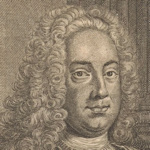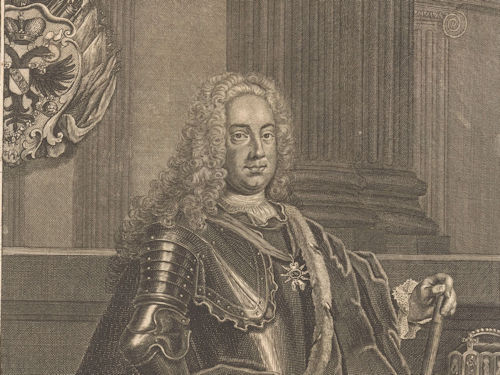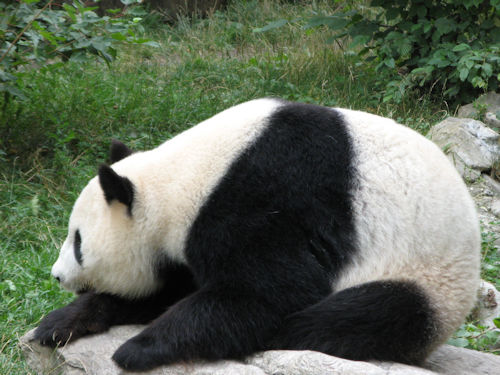
A remarkable fact for you: Vienna’s Tiergarten Schönbrunn, which sits in the park surrounding Schönbrunn Palace, is the oldest working zoo in the world.
Mind you, one or two things have changed since it opened its doors in the 18th century…
- Founded in 1752 by Emperor Franz I
- Public visitors first allowed in 1778
- Now one of the world’s top zoos
- Book Vienna zoo tickets* online
- See also:
Zoo history

(Emperor Franz I; image courtesy of the Rijksmuseum)
The zoo traces its official history back to the husband of Empress Maria Theresa; Emperor Franz I (1708-1765) established a private menagerie at Schönbrunn in 1752.
Court diary reports from the time mention how the Emperor would visit the zoo after morning Mass in the company of various courtiers.
The amply-wigged Franz was a relatively open-minded and progressive thinker (at least for the times), known particularly for his interest in science and nature. For example, his natural history collections provided the foundation for Vienna’s Natural History Museum.

(The Baroque pavilion still in the zoo and now a restaurant)
The Schönbrunn menagerie featured a circular design, radiating out from a central pavilion built in 1759.
You can still see echoes of this layout today in the southeast part of the modern zoo, just behind the main entrance. And that original Baroque pavilion now houses a restaurant.
The Schönbrunn grounds actually had a wildlife connection before Franz I’s menagerie. When Emperor Maximilian II first bought the property for the Habsburgs in the late 16th century, he converted the existing buildings into a hunting lodge.
Incidentally, Maximilian also made a huge impression on the local population by including an elephant in his procession as he entered the city for the first time as Holy Roman Emperor in 1563.
Some 200 years later, in 1770, the royal menagerie at Schönbrunn got its first elephant.
A long history with these animals followed, eventually producing one of the world’s very first zoo-born calves. Today’s large elephant enclosure opened in 1996.

(The first giraffe in Schönbrunn, 1828, Wien Museum Inv.-Nr. 199080; excerpt reproduced with permission under the terms of the CC0 licence)
Franz I’s collection remained private until a few years after his death: Schönbrunn opened to the outside world toward the end of the 1770s, thus beginning the Tiergarten’s 250-year history as a public zoo.
Recent developments
In later years, the zoo survived three particularly challenging periods.

(The rainforest house: one of many modern developments)
First, the economic deprivations of WWI: it’s hard to keep feeding animals when the local population is starving.
Second, the aerial bombing of WWII: this destroyed many of the enclosures and killed many animals.
Third, the growing awareness of animal welfare and modern zookeeping approaches in the late 1980s: this led to significant criticism of the zoo’s infrastructure and public interest in visiting fell.
(C. Ledermann jun. (also: Karl Ledermann) (manufacturer), Schönbrunn zoo – polar bear enclosure, postcard from around 1898, Sammlung Wien Museum. Excerpt from the original; reproduced with permission under the terms of the CC0 licence)
The turnaround began in the early 1990s with the appointment of Helmut Pechlaner as zoo director. His charisma and drive led to a programme of investment, rebuilding and expansion that continues today under the able stewardship of the current director Stephan Hering-Hagenbeck.
You now find the zoo’s facilities and husbandry practices at the forefront of zoological practice, which allows the institution to attract and support prestigious projects like the Giant Panda cooperation with China.

(An elephant. Or possibly a panda)
Evidence of the scale of this change comes from the annual visitor numbers, which exceeded 2 million in 2023, and from zoo rankings.
In January 2022, for example, expert Anthony Sheridan gave Tiergarten Schönbrunn the Best European Zoo Award for category A zoos (over 1 million visitors a year) for the sixth time in succession. That same year, Travel & Leisure magazine listed it in their 20 of the Best Zoos in the World article.
Franz would be proud…
To experience the zoo for yourself, check these visitor and ticket tips.
